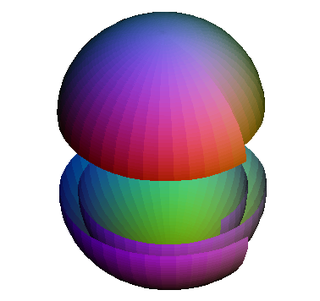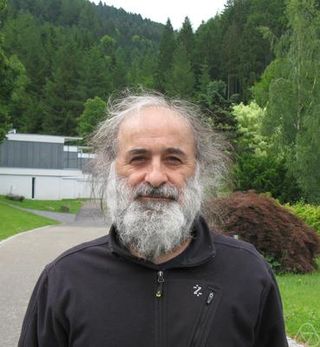
In mathematics, differential topology is the field dealing with the topological properties and smooth properties of smooth manifolds. In this sense differential topology is distinct from the closely related field of differential geometry, which concerns the geometric properties of smooth manifolds, including notions of size, distance, and rigid shape. By comparison differential topology is concerned with coarser properties, such as the number of holes in a manifold, its homotopy type, or the structure of its diffeomorphism group. Because many of these coarser properties may be captured algebraically, differential topology has strong links to algebraic topology.

In mathematics, a diffeomorphism is an isomorphism of differentiable manifolds. It is an invertible function that maps one differentiable manifold to another such that both the function and its inverse are continuously differentiable.

In mathematics, specifically in topology, the operation of connected sum is a geometric modification on manifolds. Its effect is to join two given manifolds together near a chosen point on each. This construction plays a key role in the classification of closed surfaces.

In mathematics, geometric topology is the study of manifolds and maps between them, particularly embeddings of one manifold into another.

In mathematics, low-dimensional topology is the branch of topology that studies manifolds, or more generally topological spaces, of four or fewer dimensions. Representative topics are the structure theory of 3-manifolds and 4-manifolds, knot theory, and braid groups. This can be regarded as a part of geometric topology. It may also be used to refer to the study of topological spaces of dimension 1, though this is more typically considered part of continuum theory.
In mathematics, an n-dimensional differential structure on a set M makes M into an n-dimensional differential manifold, which is a topological manifold with some additional structure that allows for differential calculus on the manifold. If M is already a topological manifold, it is required that the new topology be identical to the existing one.

In the mathematical field of algebraic topology, the homotopy groups of spheres describe how spheres of various dimensions can wrap around each other. They are examples of topological invariants, which reflect, in algebraic terms, the structure of spheres viewed as topological spaces, forgetting about their precise geometry. Unlike homology groups, which are also topological invariants, the homotopy groups are surprisingly complex and difficult to compute.
In mathematics, a 4-manifold is a 4-dimensional topological manifold. A smooth 4-manifold is a 4-manifold with a smooth structure. In dimension four, in marked contrast with lower dimensions, topological and smooth manifolds are quite different. There exist some topological 4-manifolds which admit no smooth structure, and even if there exists a smooth structure, it need not be unique.

In mathematics, a manifold is a topological space that locally resembles Euclidean space near each point. More precisely, an -dimensional manifold, or -manifold for short, is a topological space with the property that each point has a neighborhood that is homeomorphic to an open subset of -dimensional Euclidean space.
In mathematics, a differentiable manifold of dimension n is called parallelizable if there exist smooth vector fields

Selman Akbulut is a Turkish mathematician, specializing in research in topology, and geometry. He was a professor at Michigan State University until February 2020.
In mathematics, specifically in geometric topology, surgery theory is a collection of techniques used to produce one finite-dimensional manifold from another in a 'controlled' way, introduced by John Milnor. Milnor called this technique surgery, while Andrew Wallace called it spherical modification. The "surgery" on a differentiable manifold M of dimension , could be described as removing an imbedded sphere of dimension p from M. Originally developed for differentiable manifolds, surgery techniques also apply to piecewise linear (PL-) and topological manifolds.
In 4-dimensional topology, a branch of mathematics, Rokhlin's theorem states that if a smooth, orientable, closed 4-manifold M has a spin structure, then the signature of its intersection form, a quadratic form on the second cohomology group , is divisible by 16. The theorem is named for Vladimir Rokhlin, who proved it in 1952.
In mathematics, specifically geometric topology, the Borel conjecture asserts that an aspherical closed manifold is determined by its fundamental group, up to homeomorphism. It is a rigidity conjecture, asserting that a weak, algebraic notion of equivalence should imply a stronger, topological notion.
In the mathematical area of topology, the generalized Poincaré conjecture is a statement that a manifold which is a homotopy sphere is a sphere. More precisely, one fixes a category of manifolds: topological (Top), piecewise linear (PL), or differentiable (Diff). Then the statement is
Michel André Kervaire was a French mathematician who made significant contributions to topology and algebra.
In mathematics, the Kervaire invariant is an invariant of a framed -dimensional manifold that measures whether the manifold could be surgically converted into a sphere. This invariant evaluates to 0 if the manifold can be converted to a sphere, and 1 otherwise. This invariant was named after Michel Kervaire who built on work of Cahit Arf.
In mathematics, specifically geometry and topology, the classification of manifolds is a basic question, about which much is known, and many open questions remain.
In differential topology, a branch of mathematics, a Mazur manifold is a contractible, compact, smooth four-dimensional manifold-with-boundary which is not diffeomorphic to the standard 4-ball. Usually these manifolds are further required to have a handle decomposition with a single -handle, and a single -handle; otherwise, they would simply be called contractible manifolds. The boundary of a Mazur manifold is necessarily a homology 3-sphere.
In mathematics, the surgery structure set is the basic object in the study of manifolds which are homotopy equivalent to a closed manifold X. It is a concept which helps to answer the question whether two homotopy equivalent manifolds are diffeomorphic. There are different versions of the structure set depending on the category and whether Whitehead torsion is taken into account or not.






























































